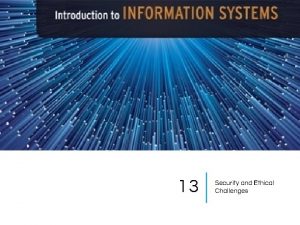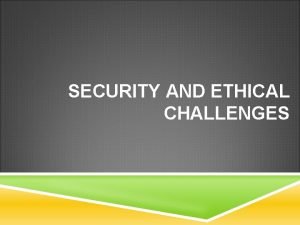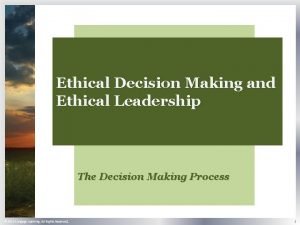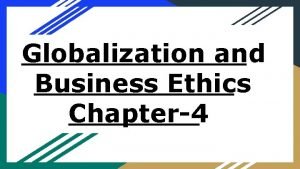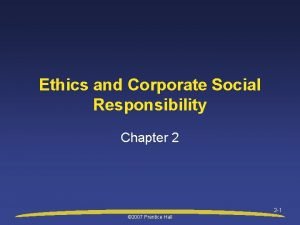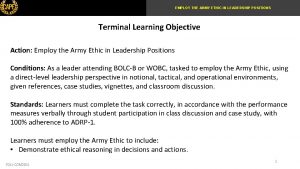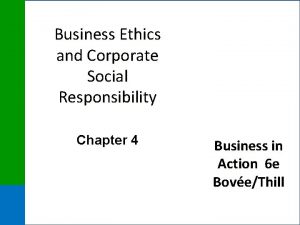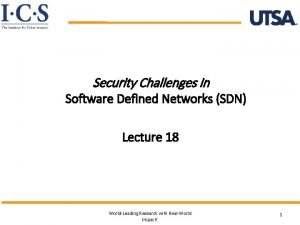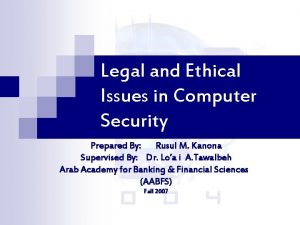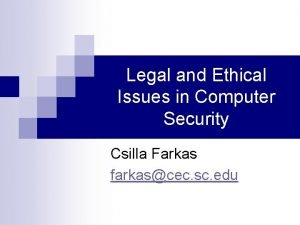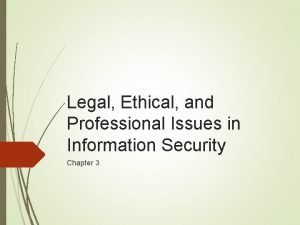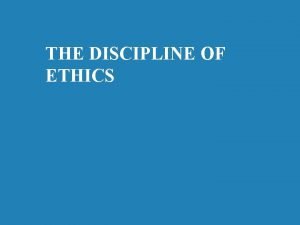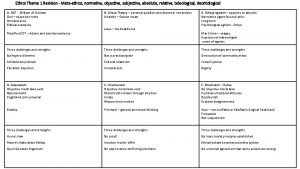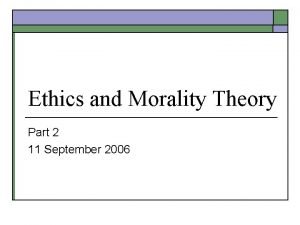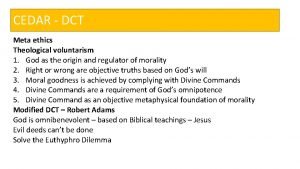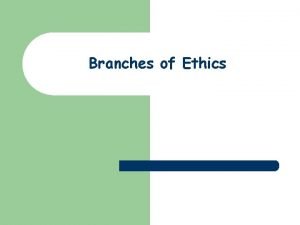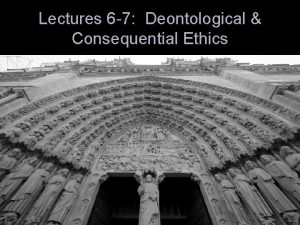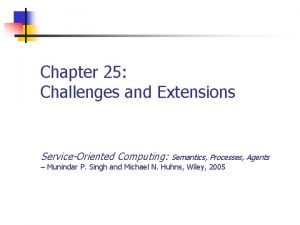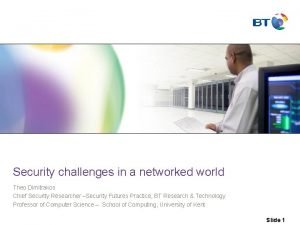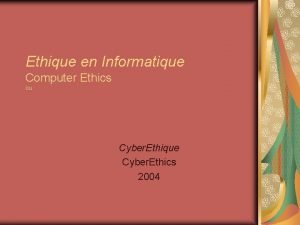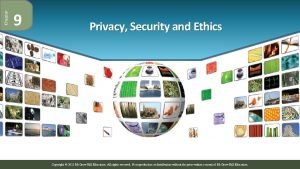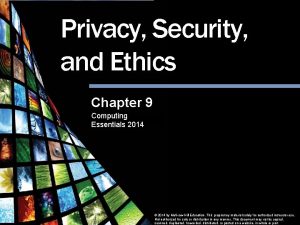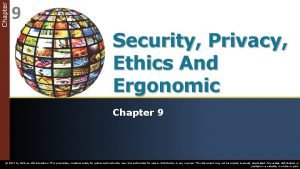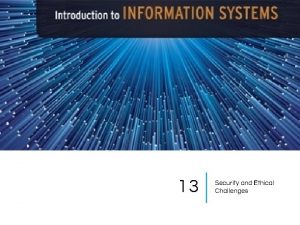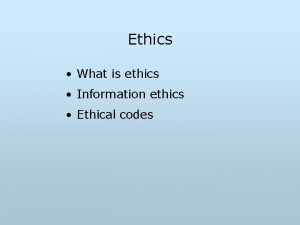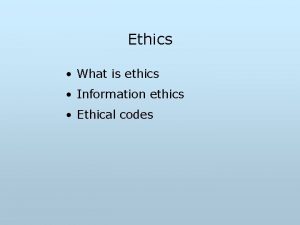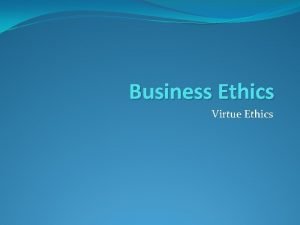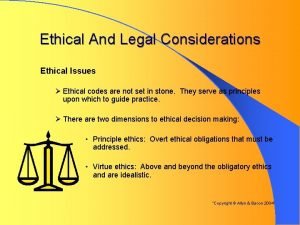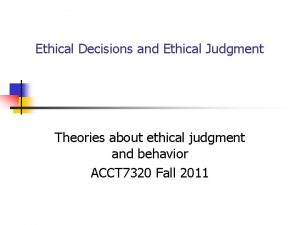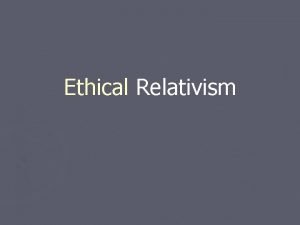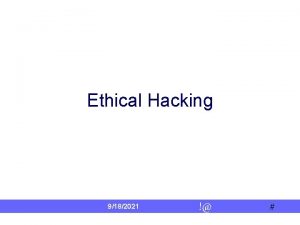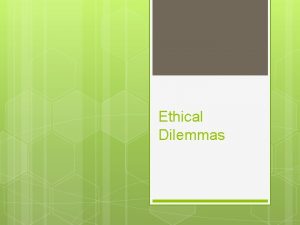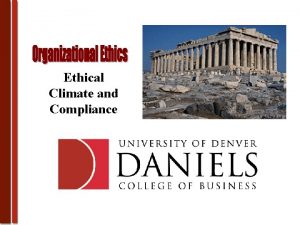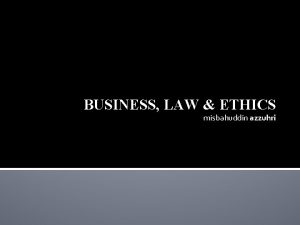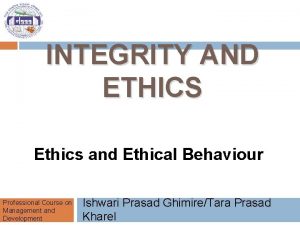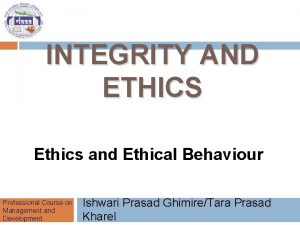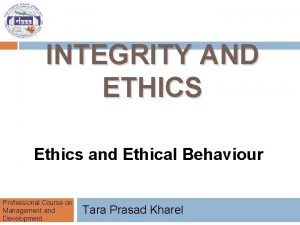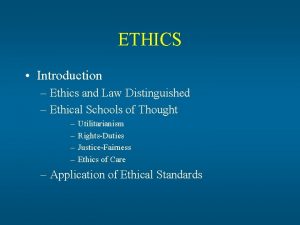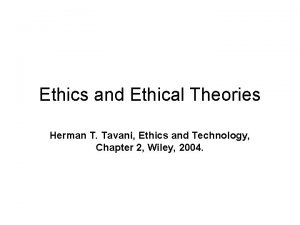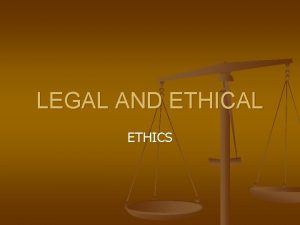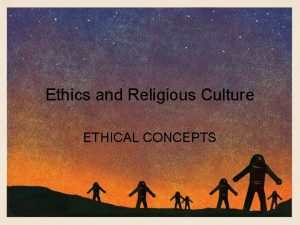SECURITY AND ETHICAL CHALLENGES IT SECURITY ETHICS AND






























- Slides: 30

SECURITY AND ETHICAL CHALLENGES

IT SECURITY, ETHICS, AND SOCIETY IT has both beneficial and detrimental effects on society and people Manage work activities to minimize the detrimental effects of IT Optimize the beneficial effects 2

BUSINESS ETHICS Ethics questions that managers confront as part of their daily business decision making include: Equity Rights Honesty Exercise of corporate power CHAPTER 13 SECURITY AND ETHICAL CHALLENGES 3

Corporate Social Responsibility Theories n n n Stockholder Theory ¨ Managers are agents of the stockholders ¨ Their only ethical responsibility is to increase the profits of the business without violating the law or engaging in fraudulent practices Social Contract Theory ¨ Companies have ethical responsibilities to all members of society, who allow corporations to exist Stakeholder Theory ¨ Managers have an ethical responsibility to manage a firm for the benefit of all its stakeholders ¨ Stakeholders are all individuals and groups that have a stake in, or claim on, a company

COMPUTER CRIME Computer crime includes Unauthorized use, access, modification, or destruction of hardware, software, data, or network resources The unauthorized release of information The unauthorized copying of software Denying an end user access to his/her own hardware, software, data, or network resources Using or conspiring to use computer or network resources illegally to obtain information or tangible property CHAPTER 13 SECURITY AND ETHICAL CHALLENGES 5

CYBERCRIME PROTECTION MEASURES CHAPTER 13 SECURITY AND ETHICAL CHALLENGES 6

HACKING Hacking is The obsessive use of computers The unauthorized access and use of networked computer systems Electronic Breaking and Entering Hacking into a computer system and reading files, but neither stealing nor damaging anything Cracker A malicious or criminal hacker who maintains knowledge of the vulnerabilities found for private advantage CHAPTER 13 SECURITY AND ETHICAL CHALLENGES 7

COMMON HACKING TACTICS Denial of Service Hammering a website’s equipment with too many requests for information Clogging the system, slowing performance, or crashing the site Scans Widespread probes of the Internet to determine types of computers, services, and connections Looking for weaknesses Sniffer Programs that search individual packets of data as they pass through the Internet Capturing passwords or entire contents Spoofing Faking an e-mail address or Web page to trick users into passing along critical information like passwords or credit card numbers CHAPTER 13 SECURITY AND ETHICAL CHALLENGES 8

COMMON HACKING TACTICS Trojan House A program that, unknown to the user, contains instructions that exploit a known vulnerability in some software Back Doors A hidden point of entry to be used in case the original entry point is detected or blocked Malicious Applets Tiny Java programs that misuse your computer’s resources, modify files on the hard disk, send fake email, or steal passwords War Dialing Programs that automatically dial thousands of telephone numbers in search of a way in through a modem connection Logic Bombs An instruction in a computer program that triggers a malicious act CHAPTER 13 SECURITY AND ETHICAL CHALLENGES 9

COMMON HACKING TACTICS Buffer Overflow Crashing or gaining control of a computer by sending too much data to buffer memory Password Crackers Software that can guess passwords Social Engineering Gaining access to computer systems by talking unsuspecting company employees out of valuable information, such as passwords Dumpster Diving Sifting through a company’s garbage to find information to help break into their computers CHAPTER 13 SECURITY AND ETHICAL CHALLENGES 10

CYBER THEFT Many computer crimes involve theft of money The majority are “inside jobs” that involve unauthorized network entry and alternation of computer databases to cover the tracks of the employees involved Many attacks occur through the Internet Most companies don’t reveal that they have been targets or victims of cybercrime CHAPTER 13 SECURITY AND ETHICAL CHALLENGES 11

UNAUTHORIZED USE AT WORK Unauthorized use of computer systems and networks is time and resource theft Doing private consulting Doing personal finances Playing video games Unauthorized use of the Internet or company networks Sniffers Used to monitor network traffic or capacity Find evidence of improper use CHAPTER 13 SECURITY AND ETHICAL CHALLENGES 12

INTERNET ABUSES IN THE WORKPLACE General email abuses Unauthorized usage and access Copyright infringement/plagiarism Newsgroup postings Transmission of confidential data Pornography Hacking Non-work-related download/upload Leisure use of the Internet Use of external ISPs Moonlighting CHAPTER 13 SECURITY AND ETHICAL CHALLENGES 13

SOFTWARE PIRACY Software Piracy Unauthorized copying of computer programs Licensing Purchasing software is really a payment for a license for fair use Site license allows a certain number of copies A third of the software industry’s revenues are lost to piracy CHAPTER 13 SECURITY AND ETHICAL CHALLENGES 14

THEFT OF INTELLECTUAL PROPERTY Intellectual Property Copyrighted material Includes such things as music, videos, images, articles, books, and software Copyright Infringement is Illegal Peer-to-peer networking techniques have made it easy to trade pirated intellectual property Publishers Offer Inexpensive Online Music Illegal downloading of music and video is down and continues to drop CHAPTER 13 SECURITY AND ETHICAL CHALLENGES 15

VIRUSES AND WORMS A virus is a program that cannot work without being inserted into another program A worm can run unaided These programs copy annoying or destructive routines into networked computers Copy routines spread the virus Commonly transmitted through The Internet and online services Email and file attachments Disks from contaminated computers Shareware CHAPTER 13 SECURITY AND ETHICAL CHALLENGES 16

SECURITY MANAGEMENT OF IT The Internet was developed for inter-operability, not impenetrability Business managers and professionals alike are responsible for the security, quality, and performance of business information systems Hardware, software, networks, and data resources must be protected by a variety of security measures CHAPTER 13 SECURITY AND ETHICAL CHALLENGES 17

SECURITY MANAGEMENT The goal of security management is the accuracy, integrity, and safety of all information system processes and resources CHAPTER 13 SECURITY AND ETHICAL CHALLENGES 18

INTERNETWORKED SECURITY DEFENSES Encryption Data is transmitted in scrambled form It is unscrambled by computer systems for authorized users only The most widely used method uses a pair of public and private keys unique to each individual CHAPTER 13 SECURITY AND ETHICAL CHALLENGES 19

PUBLIC/PRIVATE KEY ENCRYPTION CHAPTER 13 SECURITY AND ETHICAL CHALLENGES 20

INTERNETWORKED SECURITY DEFENSES Firewalls A gatekeeper system that protects a company’s intranets and other computer networks from intrusion Provides a filter and safe transfer point for access to/from the Internet and other networks Important for individuals who connect to the Internet with DSL or cable modems Can deter hacking, but cannot prevent it CHAPTER 13 SECURITY AND ETHICAL CHALLENGES 21

INTERNET AND INTRANET FIREWALLS CHAPTER 13 SECURITY AND ETHICAL CHALLENGES 22

DENIAL OF SERVICE ATTACKS Denial of service attacks depend on three layers of networked computer systems The victim’s website The victim’s Internet service provider Zombie or slave computers that have been commandeered by the cybercriminals CHAPTER 13 SECURITY AND ETHICAL CHALLENGES 23

DEFENDING AGAINST DENIAL OF SERVICE At Zombie Machines Set and enforce security policies Scan for vulnerabilities At the ISP Monitor and block traffic spikes At the Victim’s Website Create backup servers and network connections CHAPTER 13 SECURITY AND ETHICAL CHALLENGES 24

INTERNETWORKED SECURITY DEFENSES Email Monitoring Use of content monitoring software that scans for troublesome words that might compromise corporate security Virus Defenses Centralize the updating and distribution of antivirus software Use a security suite that integrates virus protection with firewalls, Web security, and content blocking features CHAPTER 13 SECURITY AND ETHICAL CHALLENGES 25

OTHER SECURITY MEASURES Security Codes Multilevel password system Encrypted passwords Smart cards with microprocessors Backup Files Duplicate files of data or programs Security Monitors Monitor the use of computers and networks Protects them from unauthorized use, fraud, and destruction Biometrics Computer devices measure physical traits that make each individual unique Voice recognition, fingerprints, retina scan Computer Failure Controls Prevents computer failures or minimizes its effects Preventive maintenance Arrange backups with a disaster recovery organization CHAPTER 13 SECURITY AND ETHICAL CHALLENGES 26

OTHER SECURITY MEASURES In the event of a system failure, fault-tolerant systems have redundant processors, peripherals, and software that provide Fail-over capability: shifts to back up components Fail-save capability: the system continues to operate at the same level Fail-soft capability: the system continues to operate at a reduced but acceptable level A disaster recovery plan contains formalized procedures to follow in the event of a disaster Which employees will participate What their duties will be What hardware, software, and facilities will be used Priority of applications that will be processed Use of alternative facilities Offsite storage of databases CHAPTER 13 SECURITY AND ETHICAL CHALLENGES 27

INFORMATION SYSTEM CONTROLS Methods and devices that attempt to ensure the accuracy, validity, and propriety of information system activities CHAPTER 13 SECURITY AND ETHICAL CHALLENGES 28

AUDITING IT SECURITY IT Security Audits Performed by internal or external auditors Review and evaluation of security measures and management policies Goal is to ensure that proper and adequate measures and policies are in place CHAPTER 13 SECURITY AND ETHICAL CHALLENGES 29

PROTECTING YOURSELF FROM CYBERCRIME CHAPTER 13 SECURITY AND ETHICAL CHALLENGES 30
 Security and ethical challenges
Security and ethical challenges Security and ethical challenges
Security and ethical challenges Ethical habits
Ethical habits What is globalization
What is globalization Perbedaan ethical dilemma dan ethical lapse
Perbedaan ethical dilemma dan ethical lapse Ethical reasoning model army
Ethical reasoning model army Chapter 4 business ethics and social responsibility
Chapter 4 business ethics and social responsibility Scholastic ethics meaning
Scholastic ethics meaning Reamers ethical decision making model
Reamers ethical decision making model Privat security
Privat security What is micro-ethics
What is micro-ethics Sdn security challenges and solutions
Sdn security challenges and solutions Professional issues in cyber security
Professional issues in cyber security Legal and ethical issues in computer security
Legal and ethical issues in computer security Legal and ethical issues in computer security
Legal and ethical issues in computer security Legal and ethical issues in information security
Legal and ethical issues in information security Descriptive ethics vs normative ethics
Descriptive ethics vs normative ethics Briefly recap
Briefly recap Descriptive ethics vs normative ethics
Descriptive ethics vs normative ethics Metaethics vs normative ethics
Metaethics vs normative ethics Descriptive ethics vs normative ethics
Descriptive ethics vs normative ethics Beneficence
Beneficence Theological voluntarism
Theological voluntarism Methaethics
Methaethics Maxim definition
Maxim definition Teleological ethics vs deontological ethics
Teleological ethics vs deontological ethics Theo dimitrakos
Theo dimitrakos Ethique informatique
Ethique informatique Chapter 9 privacy security and ethics
Chapter 9 privacy security and ethics Chapter 9 privacy security and ethics
Chapter 9 privacy security and ethics Chapter 9 privacy security and ethics
Chapter 9 privacy security and ethics
